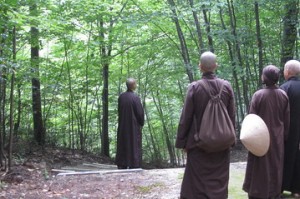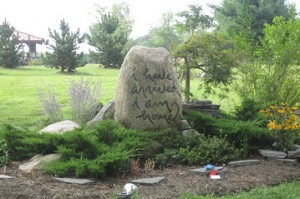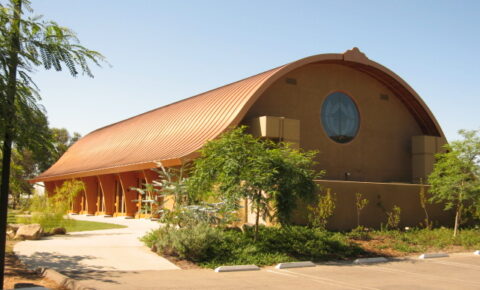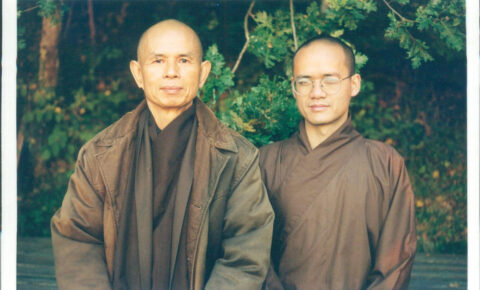
By Barbara Chai
Buddhist monk Thich Nhat Hanh led a “Day of Mindfulness” at the Blue Cliff Monastery in Pine Bush, New York, Sunday, drawing 1500 practitioners from the tri-state area.
Thich Nhat Hanh, also known as “Thay” (“master” or “teacher”), is one of the most influential spiritual leaders and Buddhist monks in the world. He was nominated for the Nobel Peace Prize by Martin Luther King Jr. in 1967, but no prize was given that year.
The Blue Cliff Monastery houses monks and nuns in Thay’s Order of Interbeing, and holds regular retreats on the grounds, located about 90 minutes from New York City.
For the Day of Mindfulness, my husband I drove from the city for a full schedule that included a Dharma talk, walking meditation, silent lunch, and deep relaxation. It was our first time experiencing this type of full-day retreat for mindfulness and meditation.
The day at Blue Cliff began with singing and Thay’s Dharma talk. When we arrived, practitioners had already taken up every cushion or chair in the meditation hall—a pile of shoes and bottled water lay at the entrance. Outside, two wings flanking the hall were set up with tents and chairs, with one section for Vietnamese translation. As we took our seats in the left wing, we saw many people sitting in lotus position with eyes closed.
The monks began by teaching everyone the words to some songs. These are the first two verses of one:
Breathing in, breathing out.
Breathing in, breathing out.
I am fresh as the dew.
I am solid as a mountain.
I am firm as the earth.
I am free.Breathing in, breathing out.
I am water reflecting
What is real, what is true,
And I feel there is space
Deep inside of me.
I am free, I am free, I am free.
Thich Nhat Hanh quietly appeared on a stone path on our left, passing those of us seated outside. Everyone inside the hall, and in our section, stood and clasped hands in prayer, all of us silent. He remained still as he moved, meditating as he walked.
He moved inside the meditation hall and sat on a raised platform next to a large and deep meditation bowl (when struck, it reverberated like a soft gong). As he began, he told us the Dharma talk would be a practice in itself.
“It’s best when we listen, we stop our thinking,” he said. He compared our minds to the soil in a garden, where there are the seeds of understanding, love, forgiveness, joy and hope.

“A good Dharma talk is a talk that can water the good seeds in us and help them to sprout and bring up the energy of joy, happiness, understanding and love,” he said.
He discussed the benefits of walking meditation, in which every step can also help those seeds grow.
“We have the habit of running and we have to learn how to stop in order for us to be able to touch deeply the present moment. The here, the now,” he said. “That is why walking means stopping. Stop the running.”
I imagined trying to meditate while walking the hectic streets of Manhattan where I work. It is possible to breathe more deeply and to count my steps as I inhale and exhale. That means walking more slowly, but not offensively so. I can think about each step (or every other step) and try to keep my mind in the moment – instead of fretting about where I had to go and what I had to do when I got there, or worrying about where I came from and what happened when I was there.
“You bring your concentration to the sole of your foot and you touch mother earth like that. You say ‘I have arrived in the here and now, where all the wonders of life are available,’” he said.
He suggested walking with two steps on the in breath, chanting to ourselves “I have arrived, I have arrived,” and three steps on the out breath, chanting “I am home, I am home, I am home.” This gives us “solidity” which prevents our mind from being pulled away, he said.
As he spoke gently, moving from topic to topic, he smiled often and punctuated his talk with quips like “Mindfulness you cannot buy in the supermarket. You have to generate it inside of us and around us.”
He also related mindfulness to our everyday lives. He said by spending two hours at a computer, we completely forget about our body. It’s at this moment I realize I haven’t looked at my iPhone all morning (and I wouldn’t look at it for most of the afternoon – if you knew me, you’d know how rare this is).
Thay told us to program mindfulness into our computers by sounding a bell every 15 minutes that would remind us to breathe deeply.
It’s not necessary to be Buddhist to practice mindfulness, he said, adding that everyone from heads of corporations to politicians could benefit from what he called “the art of happiness.”

The most moving segment for me was when we meditated as a group to music performed by the monastics – string instruments, drums, piano and a meditation bell. “We shall practice together,” he said. “We are practitioners, and not observers.” Divided into monks and nuns, the other monastics sang and chanted while Thay meditated in the center and made hand mudras.
I had been taking notes the entire time, thinking about things from the outside. But during the song, I stashed away notebook and pen and sat on the ground in lotus position. I tried to align my breaths with the music, and focused on each note. The song helped me to let go of thought, of yesterday and tomorrow, and to focus on just breathing. My breaths became deeper, and I no longer felt the ache in my left shoulder from the previous night, or the strain in my lower back from sitting in a chair.
It helped me not just to understand, but to experience his fundamental message: “I have arrived. I am home.” For that brief moment, it was true.
Original soure from The Wall Street Journal






Share Your Reflections